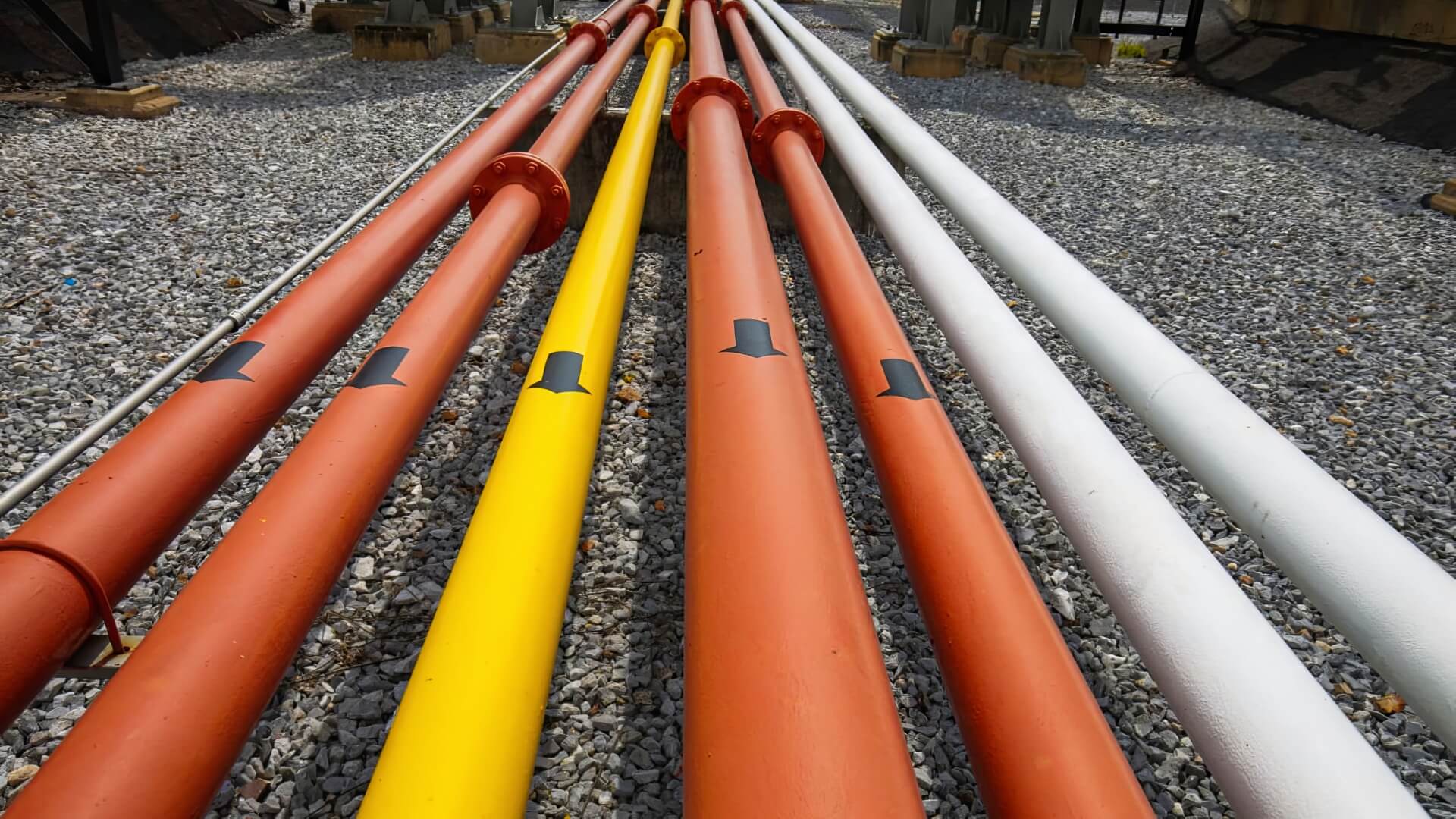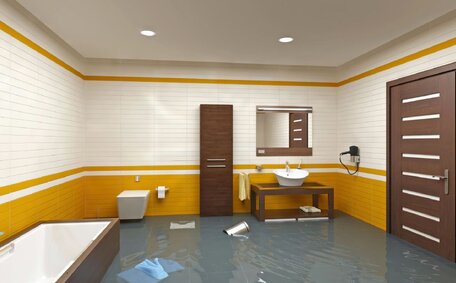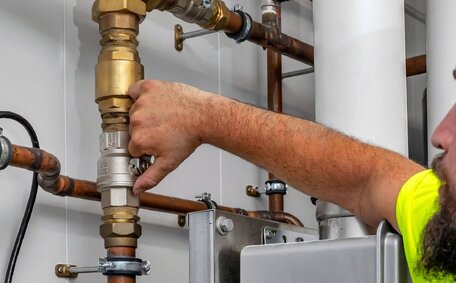Understanding Hot Water Pressure Issues
Water pressure is the measure of the force with which water flows from your heater, through pipes, to your fixtures. Adequate water pressure ensures water reaches taps and showers at a suitable pace and temperature for daily tasks. Be aware that low water pressure in your hot water system presents symptoms such as:
- Slow hot water flow from taps and showers typically signals low water pressure
- Long wait times for hot water delivery
- Noticeably reduced hot water pressure, despite fully open taps
- Hot water that doesn’t get hot enough
Insufficient hot water pressure can stem from various causes such as sediment buildup, worn fixtures, clogged pipes or filters, faulty valves, and water supply line issues. Resolving these issues, including examining the shutoff valve, is crucial for restoring hot water flow and pressure.
Checking for Sediment Buildup
Hard water can lead to sediment accumulation in your water heater over time, subsequently restricting pressure in your plumbing. This accumulation limits water flow, potentially causing both low hot water pressure and elevated temperatures. Homeowners should look out for gradual symptoms such as longer wait times, reduced flow, absence of hot water, or discoloured water.
To check for sediment buildup, inspect the hot water heater by draining a few litres of water from the tank’s spigot. If the water appears dirty or discoloured instead of clear, there is likely considerable sediment buildup that can cause low hot water quality, making it essential to call professional help. Annual flushes, which your plumber can efficiently provide, help prevent major buildup.
We also recommend checking taps, showerheads, and other fixtures for flow restrictions from scale and sediment, which are most likely impeding your flow. Note that while draining the tank helps assess the issue, significant buildup often requires a full system flush by an experienced plumber to remove deposits and restore pressure.
Flushing the Water Heater
Flushing the water heater is critical for removing sediment and scale accumulation in the tank. It’s recommended to flush hot water cylinders annually to optimise performance and pressure.
The process involves draining your tank of water, then thoroughly rinsing the interior components with a high-powered stream to tackle the lack of pressure. This clears out mineral sediment and scale that accumulate over time due to hard water. It can significantly increase your hot cold water flow and restore pressure if sediments have built up.
DIY flushes can be risky without proper knowledge of the pressure requirements for hot water systems. Improper flushing can cause damage and reduce the necessary pressure for your system. Our team uses professional-grade equipment to ensure we flush both electric and gravity fed hot water systems without causing leaks or other issues.
Annual flushes prevent sediment buildup, improve water flow, and reduce the risk of heater failures, thus extending the system’s longevity. It also optimises energy efficiency. To learn more or schedule a hot water system flush, contact Moorebank Plumbing.
Replacing the Water Heater
Replacing a hot water tank that is over 10 years old or demonstrates issues with reduced pressure often restores flow effectively. A new, correctly sized water heater can enhance both pressure and temperature consistency.
Consider factors such as energy efficiency, tank size, warranty, and features like Wi-Fi when choosing a new system. Gas hot water heating systems typically recover hot water faster but electric heaters have lower operating costs. Contact our team at Moorebank Plumbing to explore what do fixes I need for the ideal replacement based on your household needs and budget.
Upgraded units enhance cold water pressure, reducing sediment accumulation in more efficient models. Newer heaters have improved water heating elements and advanced components not susceptible to the same mineral buildup and wear that can restrict flow in outdated systems. This helps provide reliable pressure.
As licensed installers, we ensure full removal and installation of new water heaters, restoring optimal pressure and temperature. All work is backed by a satisfaction guarantee. Reach out now to get a quote.
Inspecting Pipes and Fixtures
It’s important to inspect the hot water tank, pipes, and fixtures when troubleshooting pressure issues. A faucet that takes a while to fill up could signify wear, corrosion, or mineral scale on fixtures impeding water flow and could be the signal of your low hot water pressure issue.
Inspect all visible plumbing fixtures and connections for wear that might suggest low pressure. Look for rust, leaks, scaling, or blockages, as these can affect pressure levels and increase the risk of leaks or bursts.
Replacing corroded pipes and worn fixtures can improve water flow and restore pressure. A plumber can also descale pipes, ensuring clean water in your home, and clear partially closed clogs that may not be visible on a DIY inspection. Contact our team if you spot any concerning drop water pressure damage during inspection so we can assess and remedy it.
Clearing Clogs and Blockages
Clogged pipes, water filters, or fixtures can restrict water flow and cut hot water pressure. Signs of pressure slow just one clog include:
- Reduced flow from hot taps even when fully open
- Dripping or sputtering from faucets
- higher than normal sounds from pipes when delivering hot cold water
- Your toilet that is slow just to demonstrate one symptom of a pressure issue
First, eliminate visible blockages from fixtures and pipes to restore water flow.
Try removing and cleaning aerators and showerheads, as it may increase your water flow.
If DIY efforts fail to clear the clog, contact our team. We use state-of-the-art drain cleaning equipment to clear even severe clogs without damaging water pipes. This can bring hot water pressure back to normal.
Preventative drain maintenance every 6-12 months reduces chances of major clogs. Our technicians also check your entire water system health during maintenance visits.
Replacing Faulty Parts
Failure of components such as pressure regulators and valves can result in reduced hot water pressure. We recommend checking and potentially replacing the tempering valve every 5 years as they wear out over time.
Visible leaks, corrosion, diminished flow, and fluctuating water temperature can signify parts in need of replacement. Malfunctioning components like a broken pressure regulator can lead to flow water pressure that is too high, resulting in dangerously high levels or inversely too low.
Our licenced technicians can inspect your hot water system and identify any faulty parts needing repair or replacement to restore pressure low areas in your system. We carry a full range of plumbing parts and components to promptly address issues within your homes.
Replacing worn out or damaged hot water system parts, like the shut off valve, can optimise pressure, temperature, and flow. Investing in preventative maintenance checks at least annually can also fix low hot water issues before they become bigger problems affecting your everyday comfort and convenience.
Upgrading Your Water System
Persistent low water pressure that resists standard troubleshooting may necessitate upgrading your home’s water system components. This involves replacing key parts with higher capacity options, such as:
- Installing a larger hot water cylinder or multiple tanks
- Switching to a gas or electric hot water booster pump for increased pressure
- Replacing narrow pipework with wider diameter piping
- Upgrading to a water main where pressure could be higher
Upgrading from 12mm to 20mm diameter pipes can quadruple water velocity. Combining pipe upgrades with a brand new high efficiency water heater and booster pump can significantly increase pressure.
The right upgrades to enhance pressure depend on various factors, helping you figure out why your home requires specific adjustments. Our team can advise on the most suitable solutions to meet your household needs after an in-depth site inspection. We handle all required installations and ensure the upgrades restore adequate hot water pressure.
Installing a Booster Pump
A booster pump is an additional pump installed to increase water pressure in homes with persistent low pressure issues. By intensifying the pressure from the main water supply line, booster pumps can alleviate the cause of low hot water pressure and significantly improve flow rate to fixtures.
When selecting a hot water booster pump, consider factors like:
- compatibility with your home’s plumbing infrastructure
- Pump power/capacity matched to household size and peak demand
- Pressure range - 30 to 50 PSI is typical
- Auto-on/off settings
- Energy efficiency ratings
Our licensed technicians can evaluate your storage needs and install suitable booster pumps after inspecting your system. We handle all modifications to ensure seamless integration and water pressure slow just boosted throughout your home’s hot water lines. Contact us today for a quote on adding this effective solution.
Switching to a Tankless System
Tankless water heaters, also called on-demand or instantaneous water heaters, provide hot water without using a storage tank. Instead, water is heated directly whenever you turn the tap from cold to hot. This continuous drop water flow on demand can support higher water pressure.
Benefits of switching to a tankless system include:
- Higher hot water pressure with continuous flow
- Unlimited hot water supply that never runs out
- Compact, space-saving unit design
- Greater energy efficiency without standby losses
When installing a new tankless system, our licenced technicians consider factors like:
- Sizing the heater to match your households peak hot water demand
- Gas vs electric models
- Indoor vs outdoor installation space
- Modifications needed to existing plumbing lines
While tankless heaters have a higher upfront cost, reflected on your water meter, they can save on energy bills in the long run. Contact our team to learn if a tankless water heater is right for your home.
Contacting a Professional Plumber
For ongoing hot water pressure issues that persist despite troubleshooting efforts, contacting a professional plumbing service is highly recommended. At Moorebank Plumbing, we have over 10 years of experience assessing and resolving all types of hot water system problems for homes and businesses across Moorebank and wider Sydney.
Our qualified technicians will thoroughly inspect and service your hot water unit and connected plumbing to identify and address the root cause of low pressure. We use state-of-the-art leak detection equipment, pipe inspection cameras, pressure gauges and more to find out the root cause and properly evaluate your system.
Based on the results, we’ll advise on the necessary repairs, parts replacements or system upgrades needed to restore strong, steady hot water pressure throughout your home. We handle everything from clearing clogs and replacing valves to installing tankless systems, booster pumps and repiping jobs.
In addition to addressing hot water pressure problems, Moorebank Plumbing offers services such as:
- Same day emergency plumbing
- Gas line repairs and installation
- Drain cleaning and pipe relining solutions
- Backflow testing and prevention
- Leaking tap and pipe repairs
- Hot water system installation
For superior workmanship backed by our satisfaction guarantee, call us at 1300 349 338 or email to schedule service.






